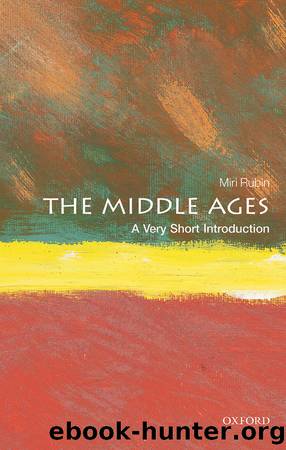The Middle Ages: A Very Short Introduction by Miri Rubin

Author:Miri Rubin [Rubin, Miri]
Language: eng
Format: epub
ISBN: 9780199697298
Publisher: Oxford University Press
Published: 2014-08-27T00:00:00+00:00
The Church in search of liberty
With the growth of the European economy and the decline of the frequency of disruptive invasions, a more integrated Europe was emerging soon after the year 1000. Recent conversion had brought Iceland as well as Bohemia into the religious and dynastic fold of Europe, Poland as well as Denmark. Migration from the more densely settled west to the east meant that intensive agrarian methods were spread, so more plentiful foodstuff was grown to support growing populations. In many of these activities ecclesiastical institutionsâmonasteries above allâled the way: they were a relatively stable presence, endowed by members of local elites, and home to recruits from those classes too. Monasteries were sometimes vanguards of political and economic power: when Guifred, Count of Urgel repopulated Catalonia in the late 9th century, he did so with monasteries planted in the plain of Urgel.
Bishops led their surrounding diocese from churches that came to be known as cathedrals, after the bishopâs throneâcathedra. Most European cities had a baptismal church where the lives of local people became Christian. The most prominent citiesâold Roman civitates, hence the word cityâserved as administrative centres for ecclesiastical and secular affairs. Even as other churches and chapels were built at the tombs of saints, these existed in subordination to the baptismal church, the cityâs mother church.
Despite the influence of religious houses, the occasional support of landed families, and the sporadic inspiration of holy people, provision in the countryside was patchy, and until the 12th century bore little uniformity across Europe. Aristocratic households had their domestic chaplains, and their members were able to found monasteries and nunneries. Landlords built churches on their estates for their dependants; they appointed priests and furnished the needs of the altar. Bishops played an important role in offering centres for training of the clergy in cathedral schools. Before 1000 it was still possible for married men to become priests and to maintain their families.
However far it may have seemed from some of Europeâs provinces, Rome was an unrivalled Christian centre. Imperial symbolism was still palpable in the rituals of the papacy: vestments, chant, and titles. Popes promoted not only local Roman saintsâthe martyrs Peter and Paul, Nereus and Achileusâbut also the cult of the Virgin Mary, which had developed early and vigorously in Constantinople. In Rome, Charlemagne sought to be crowned in the year 800. Later German kings sought elevation there too. It was indeed such a Holy Roman EmperorâHenry III (1017â56)âwho encouraged the conception of the Church in the world as a hierarchical bureaucratic structure with the pope as its head. Popesâas bishops of the unique city of Rome and vicars of Christ on earthâinvested bishops with their office and authority, and these in turn supervised the diocese and all its believers like good shepherds. Or so was the ideal.
The vision now emanating from Rome was one of Church hierarchy and discipline, and of freedom from secular powersâlibertas ecclesiae, freedom of the Church. Similar ideas had been expressed earlier in the century
Download
This site does not store any files on its server. We only index and link to content provided by other sites. Please contact the content providers to delete copyright contents if any and email us, we'll remove relevant links or contents immediately.
Machine Learning at Scale with H2O by Gregory Keys | David Whiting(4074)
Harry Potter and the Goblet Of Fire by J.K. Rowling(3755)
Never by Ken Follett(3750)
Unfinished: A Memoir by Priyanka Chopra Jonas(3306)
Fairy Tale by Stephen King(3186)
The Man Who Died Twice by Richard Osman(2977)
Will by Will Smith(2763)
Rationality by Steven Pinker(2266)
The Dark Hours by Michael Connelly(2208)
It Starts With Us (It Ends with Us #2) by Colleen Hoover(2170)
The Storyteller by Dave Grohl(2146)
Can't Hurt Me: Master Your Mind and Defy the Odds - Clean Edition by David Goggins(2129)
The Dawn of Everything: A New History of Humanity by David Graeber & David Wengrow(2102)
Friends, Lovers, and the Big Terrible Thing by Matthew Perry(2095)
The Becoming by Nora Roberts(2055)
The Stranger in the Lifeboat by Mitch Albom(2025)
Cloud Cuckoo Land by Anthony Doerr(2010)
Einstein: His Life and Universe by Walter Isaacson(1941)
Love on the Brain by Ali Hazelwood(1930)
